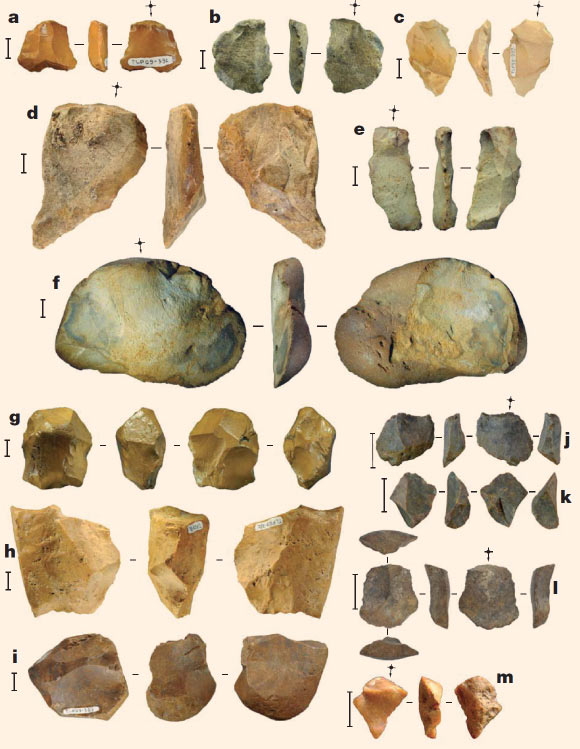New archaeological evidence published online in the journal Nature has pushed back the accepted earliest human occupation of Sulawesi to more than 110,000 years ago.

Finds from Talepu excavations: flakes (a-f, j-m), cores (g, h, i). All artifacts shown are silicified limestone. Scale bars -10 mm (a-i), 20 mm (j-m). Image credit: Gerrit D. van den Bergh et al.
“Previously, it was thought that the first people to set foot on this remote island were early modern humans who arrived as part of the colonization of Australia around 50,000 years ago,” explained co-author Dr Adam Brumm, an archaeologist with Griffith University and the University of Wollongong.
“However, the newly discovered stone tool findings from Sulawesi, at 118,000 years in age, are more than twice as old as the earliest known sites in Australia, and are possibly significantly older.”
Dr Brumm and his colleagues excavated an open-air site called Talepu in the Walanae Basin northeast of Maros, Sulawesi.
“Our excavations focused on the northernmost hill of an elongated ridge near Talepu village, about 600 m west of the Walanae River. The Talepu Hill summit lies 32 m above sea level and 18 m above the adjacent Walanae River floodplain,” the archeologists explained.
They unearthed stone artifacts dating back at least 118,000 years, together with the fossil remains of megafauna (Bubalus sp., Stegodon and Celebochoerus).
The human species that made these stone tools remains an enigma, as no human fossils have been found at the site. They could have been Homo erectus, distant relatives of Homo floresiensis from the Flores, or the enigmatic Denisovan hominins of eastern Asia.
“With regards to potential island colonizers, there are at least three candidates in the region: the known and inferred distributions of Homo floresiensis on Flores, H. erectus on the southern margin of Sunda, and Denisovans, whose geographic range may have extended into Wallacea,” the scientists said.
According to their Nature paper, an enigmatic hominin group colonized the Indonesian island of Flores at least one million years ago. However, by 50,000 years ago modern humans had crossed to Sahul, the landmass composed of Australia and Papua.
“It now seems that before anatomically modern Homo sapiens entered the island, there might have been pre-modern hominins on Sulawesi at a much earlier stage,” said lead author Dr Gerrit van den Bergh, of the University of Wollongong.
“It was possible that – like the island of Flores where Homo floresiensis fossils were discovered more than a decade ago – fossils of pre-modern humans may yet be found on Sulawesi.”
_____
Gerrit D. van den Bergh et al. 2016. Earliest hominin occupation of Sulawesi, Indonesia. Nature 529, 208-211; doi: 10.1038/nature16448







